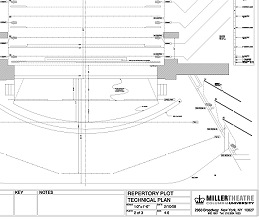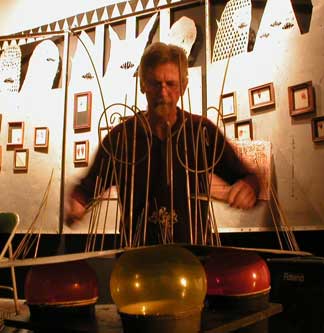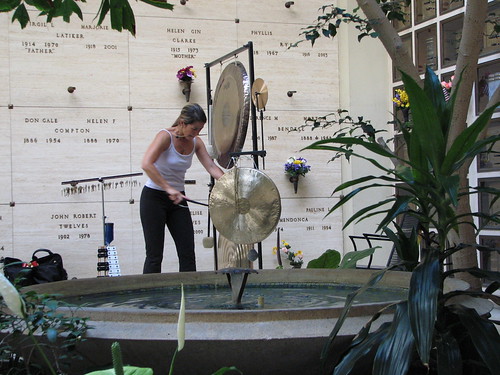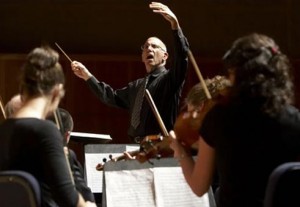 Ronen Givony’s Wordless Music is back at Miller Theater this Sept. 9-12, doing it’s indie-rock/electronic/classical/new-music thing. The 9th brings back the 802 Tour (Nico Muhly, Sam Amidon and Doveman, w/ special guest Nadia Sirota); the 10th welcomes Do Make Say Think and DMST founder Charles Spearin’s “The Happiness Project”; the 11th features Tim Hecker, Grouper, and Julianna Barwick; and the 12th caps it off with Destroyer and Loscil performing a rare collaborative set of original music from each artist’s catalog, then the JACK Quartet. All shows start at 8pm, with tickets setting you back $15-$20. Columbia University’s Miller Theatre is located north of the main campus gate at 116th St & Broadway, on the ground floor of Dodge Hall.
Ronen Givony’s Wordless Music is back at Miller Theater this Sept. 9-12, doing it’s indie-rock/electronic/classical/new-music thing. The 9th brings back the 802 Tour (Nico Muhly, Sam Amidon and Doveman, w/ special guest Nadia Sirota); the 10th welcomes Do Make Say Think and DMST founder Charles Spearin’s “The Happiness Project”; the 11th features Tim Hecker, Grouper, and Julianna Barwick; and the 12th caps it off with Destroyer and Loscil performing a rare collaborative set of original music from each artist’s catalog, then the JACK Quartet. All shows start at 8pm, with tickets setting you back $15-$20. Columbia University’s Miller Theatre is located north of the main campus gate at 116th St & Broadway, on the ground floor of Dodge Hall.

That’s what early settlers said about the wild mint growing all over the peaceful hills and oceanside that would one day be paved over and known as San Francisco. In fact, for many years starting in 1835, that’s what the settlement was called, only in Spanish: Yerba Buena.
History lives on in the name of Yerba Buena Center for the Arts, located on 3rd Street between Mission and Howard. YBCA’s New Frequencies performance series, curated by Performing Arts Manager Isabel Yrigoyen, is well underway, and offers a couple of intriguing choices in coming days.
First on Saturday evening, August 22, we have local avant-cabaret luminary Amy X Neuburg, backed up by the Cello ChiXtet of Jessica Ivry, Elaine Kreston and Elizabeth Vandervennet. Their set consists of selections from The Secret Language of Subways, a song cycle for voice, cello trio, electronic percussion and live electronic processing which Neuburg conceived of while riding New York City subways. It begins promptly at 8:00 p.m. in the YBCA Forum, and serves as an opener for Argentine singer/composer Juana Molina, who’ll take the stage at 9:05. Tickets are $25 general and $20 for YBCA members, students, seniors, and teachers.
If visual art is your thing, you can have that plus contemporary music on the same evening on Thursday, August 27. Gallery visitors will find that’s one of the nights musicians have been called in to respond directly to the work of the eight visual artists commissioned for the Wallworks exhibition. The August 27th contingent will be composer, pianist, and electronic musician Chris Brown, Mason Bates (as DJ Masonic), and upright bassist David Arend. Their sounds are free with gallery admission: $7 regular, or $5 for seniors, students, and teachers. (And non-profit employees, KQED members, and folks carrying a valid public transportation pass or a public library card.)
 San Francisco’s Mission District, home of so much that is cool, is a natural neighborhood for the arts. The San Francisco Community Music Center located at 544 Capp Street is the the Bay Area’s oldest community arts organization and San Francisco’s largest provider of low-cost, high quality music education. In 2008, 2,300 students of all ages, ethnicities and income levels enrolled in Music Center programs and over 16,000 people enjoyed musical performances at no or low cost.
San Francisco’s Mission District, home of so much that is cool, is a natural neighborhood for the arts. The San Francisco Community Music Center located at 544 Capp Street is the the Bay Area’s oldest community arts organization and San Francisco’s largest provider of low-cost, high quality music education. In 2008, 2,300 students of all ages, ethnicities and income levels enrolled in Music Center programs and over 16,000 people enjoyed musical performances at no or low cost.
Starting this Sunday, the SFCMC will host the eighth annual Outsound New Music Summit, a festival which for all its success and longevity has somehow stayed the Bay Area’s best-kept secret. Sunday night’s “Touch the Gear” expo is free and open to the public, featuring 20 individual artists and ensembles and their homemade, customized, and startling instruments and electronic rigs. All of them will be set up and ready to show you, the audient, how to make music and noise like they do.
Four concert nights follow on the subsequent Wednesday, Thursday, Friday and Saturday night. Artist Q & A sessions at 7:15 p.m. each evening set you up for performances starting at 8:00 p.m., starring:
- Alicia Mangan & Spirit, ROVA Saxophone Quartet, and Vinny Golia (solo and with locals in a mixed ensemble) in “Free Improvision/Free Composition”
- Forms of Things Unknown, Peter Kolovos, Conure, Hans Fjellestad, and Thomas Dimuzio in “Industrial Soundscapes”
- Jess Rowland & The Dreamland Puppet Theater, Kathleen Quillian & Gilbert Guererro, and Bonfire Madigan in “InterMedia”
- Natto, Ghost In the House featuring Waterphone inventor Richard Waters, and Left Coast Improv Group in “Deep Listening and Introspection”
Full scheduling details and performer bios can be found in the online schedule. Tickets are available in advance from Brown Paper Tickets, or for $10.00 at the door.
 I’ve been working so hard today I’ve forgotten to eat, and it’s in that spirit of lightheadedness and poor impulse control that I share with you the following San Francisco Bay Area new music scene update.
I’ve been working so hard today I’ve forgotten to eat, and it’s in that spirit of lightheadedness and poor impulse control that I share with you the following San Francisco Bay Area new music scene update.
The Lab’s 25th anniversary performance series is well underway, and in just one night, they’ll run the gamut of styles celebrating their audacious artistic vision. On Thursday, July 2nd, Mills College’s own Chris Brown will curate and perform in a concert featuring Charles Johnson, Chad and Curtis McKinney, Tom Nunn and William Winant.
When Johnson et. al. take the stage, you’ll hear amplified string and percussion instruments tuned in just intonation, combined with analog electronics configured to create difference tones. Chad and Curtis McKinney are twin brothers whose SuperCollider-based computer network music makes a tightly interwoven, visceral and strongly rhythmic combo. Chris Brown will put on his electroacoustic hat, teaming up with instrument inventor Tom Nunn to tangle with legendary percussionist William Winant.
If you can’ t make it this week, never fear, since the series will continue next week with Miya Masaoka and Tomas Phillips on Thursday, July 9th, and a multimedia event the next night with Nao Bustamante, Margaret Tedesco, and Cliff Hengst. Performance artist Bustamante will embody 1940s Dominican movie starlet Maria Montez, using video and the body as a source of backdrop, narrative, and emotion, taking audiences on a journey all over the body and its bejeweled parts.
The Lab is conveniently located at 2948 16th Street, San Francisco, near the 16th and Mission BART station. They’ll let you in for $8.00 at the door. For more information, call (415) 864-8855.
 The San Francisco Bay Area has a unique way of celebrating the first day of summer. Our most popular new music event, the Garden of Memory, comes around every summer solstice, and reliably attracts more than 1,000 visitors while creating a parking nightmare for miles in every direction. In 2007 I was forced, like many attendees, to park in the nearby cemetery and accidentally backed over the curb. I left my car there and hurried away apologizing profusely for actually driving over somebody’s grave.
The San Francisco Bay Area has a unique way of celebrating the first day of summer. Our most popular new music event, the Garden of Memory, comes around every summer solstice, and reliably attracts more than 1,000 visitors while creating a parking nightmare for miles in every direction. In 2007 I was forced, like many attendees, to park in the nearby cemetery and accidentally backed over the curb. I left my car there and hurried away apologizing profusely for actually driving over somebody’s grave.
Every year over 30 composers, improvisers, and sound-artists take over the columbarium at the Chapel of the Chimes, located at 4499 Piedmont Avenue in Oakland. The concert takes place on the summer solstice regardless of the day it falls on, and this year it’s Sunday, June 21st, starting at 5:00 p.m. and continuing until 9:00 p.m. or sundown, whichever comes first.
The first time I attended the Garden of Memory concert was also the first year I participated, though I wasn’t on the list of lucky featured performers. In 2003 my friend Christi Denton was assigned a space in the columbarium, as all participating artists are, for her multi-speaker sound installation. Recordings of me playing flute multiphonics, and giving a tarot card reading, were among those she looped for the installation, whose speakers hung above a collection of ferns in one of the columbarium spaces, like the fruit of a robot tree, filling the room with the disembodied voices and music of women.
Few new music events in this or any city are as family-friendly, visually stunning and sonically varied. If you plan to spend your Sunday evening in the Garden of Memory, public transit is recommended. Admission is $15.00 general, $10.00 for students and seniors, and $5.00 for kids under 12 (kids under 5 are free). Tickets are available at the door, or in advance from www.brownpapertickets.com.
 Seda Röder is a Turkish pianist who currently teaches in Boston. Those of you who are interested in electroacoustic music may remember her performance back in April during the New York City Electroacoustic Music Festival at the CUNY Graduate Center. If you live near Boston, take a look at her website: she will be playing four concerts in the area between September and the end of the year.
Seda Röder is a Turkish pianist who currently teaches in Boston. Those of you who are interested in electroacoustic music may remember her performance back in April during the New York City Electroacoustic Music Festival at the CUNY Graduate Center. If you live near Boston, take a look at her website: she will be playing four concerts in the area between September and the end of the year.[Ed. note: Polly Moller is not just busy telling you about concerts like the one below — while she’s out there pushing for the other guy, I want to mention the she herself has what looks like a great gig, with Pamela Z and Jane Rigler, May 17th at the Royce Gallery, 2901 Mariposa Street (between Harrison & Alabama), SF. tickets are $10, and you can see more here. Go, Polly! …OK, on with the show…]
 Sequenza21 readers are a quirky and unpredictable bunch. But I’m willing to bet that any of them who show up on Wednesday, May 20, Friday, May 22, or Saturday, May 23 at Davies Symphony Hall in San Francisco will not spend the first half fidgeting around, waiting for the marvelous Yuja Wang to take the stage, so they can text their friends about what kind of gown she’s wearing. No, our readers will be on the edges of their seats ready for the world premiere of The B-Sides by Mason Bates!
Sequenza21 readers are a quirky and unpredictable bunch. But I’m willing to bet that any of them who show up on Wednesday, May 20, Friday, May 22, or Saturday, May 23 at Davies Symphony Hall in San Francisco will not spend the first half fidgeting around, waiting for the marvelous Yuja Wang to take the stage, so they can text their friends about what kind of gown she’s wearing. No, our readers will be on the edges of their seats ready for the world premiere of The B-Sides by Mason Bates!
The internet got a taste of Bates’ new work on April 15th, when the YouTube Symphony Orchestra, led by San Francisco’s own Michael Tilson Thomas, played the final movement, “Warehouse Medicine”, in Carnegie Hall. Bates explains in the program notes that his five-movement piece is “informed by the grooves of electronica as well as the modern masters of orchestral sonority, and might also be said to inhabit the ‘flipside’ of the symphonic world – a place where drum-n-bass rhythms meet fluorescent orchestral textures.”
The B-Sides is dedicated to MTT, who commissioned it. The maestro invited the composer backstage during a concert intermission in November 2007, “between Tchaikovsky and Brahms,” Bates recalls. “He suggested a collection of five pieces focusing on texture and sonority—perhaps like Schoenberg’s Five Pieces for Orchestra. Since my music had largely gone in the other direction—large works that bathed the listener in immersive experiences—the idea intrigued me. I had often imagined a suite of concise, off-kilter symphonic pieces that would incorporate the grooves and theatrics of electronica in a highly focused manner.”
Something else Sequenza21 readers are likely to do, if they attend the Friday, May 22 show, is stick around for Davies After Hours. It’ll be hard to resist, with Bates morphing into his alter-ego, DJ Masonic, and joining SF Symphony Resident Conductor Benjamin Schwartz to host a hybrid concert/reception they call Mercury Lounge: Mercury Soul Comes to Davies. DJs and chamber ensembles will offer their reflections on the night’s concert…which oh, by the way, includes Sibelius’ Symphony No. 4 in A minor, Opus 63.
Tickets are available online, and also by phone from the San Francisco Symphony Box Office at (415) 864-6000.
 Interpretations continues its twentieth season of provocative programming in New York City. Founded and curated by baritone Thomas Buckner in 1989, Interpretations focuses on the relationship between contemporary composers from both jazz and classical backgrounds and their interpreters, whether the composers themselves or performers who specialize in new music. To celebrate, Jerry Bowles has invited the artists involved in this season’s concerts to blog about their Interpretations experiences. The concert on 12 March 2009 is a recital by the producer himself, baritone Thomas Buckner. He took time out of his busy schedule to tell us in his own words about the series and his concert on it:
Interpretations continues its twentieth season of provocative programming in New York City. Founded and curated by baritone Thomas Buckner in 1989, Interpretations focuses on the relationship between contemporary composers from both jazz and classical backgrounds and their interpreters, whether the composers themselves or performers who specialize in new music. To celebrate, Jerry Bowles has invited the artists involved in this season’s concerts to blog about their Interpretations experiences. The concert on 12 March 2009 is a recital by the producer himself, baritone Thomas Buckner. He took time out of his busy schedule to tell us in his own words about the series and his concert on it:
On Thursday March 12, the Interpretations series continues its twentieth season. As the series founder and artistic director, I am grateful to Sequenza 21 for featuring our series. The series was founded to nurture community of new music composers and their interpreters. Sequenza 21 nurtures our community by allowing us to communicate with one another.
I am often asked what draws me to the music I present and perform. An answer I have often given is that, whereas many people can make music that sounds like music, I am interested on people who make music that sounds like them. It is a criterion well met by the music I have chosen to present in my concert of new music for voice. Each or the composers is a true original.
The first half of the concert will feature an extended work written for me by composer/pianist “Blue” Gene Tyranny, whom I got to know through our work in the operas of Robert Ashley. The piece, “Somewhere Songs”, has an original text by the composer and is for voice and electronically reproduced sounds. The three songs concern friendship in extraordinary circumstances and are “based on true stories about hidden places, depicted physically, psychologically and socially in specific word idioms.” There is a natural musicality and a sense of mystery in these songs. They have been released on a recent CD of “Blue”s music on the mutable music label.
The next piece in the concert, “T-Language”, made by Tom Hamilton and me, is an improvisation for voice and electronics. We have sought to give the work a clear identity by using recorded vocal improvisations to shape the electronic sounds. Tom and I have worked together for years, and this piece has been developing really well. Our previous recordings include Tom’s “Off Hour Wait State” and our collaboratively created “Jump the Circle, Jump the Line.”
The concert ends with “Beats”, composed by Stuart Saunders Smith for me and my long time collaborator, pianist Joseph Kubera. The texts are from Jack Kerouac and Walt Whitman. It is not a song cycle. Rather, the texts are spoken with piano accompaniment, and the voice sings wordlessly. The music is extremely complex rhythmically. A friend of mine characterized one of Stuart’s pieces as sounding like Roscoe Mitchell, Mallachai Favors and Lester Bowie improvising, but exactly notated. This music is challenging and enjoyable to perform and listen to. It also requires us both to play percussion and has a theatrical flair characteristic of Stuart’s music.
Those of you who have seen the publicity for this concert know that I was also to perform a work by Fred Ho for baritone saxophone and baritone voice. Fred has been waging a courageous war against cancer. He is doing very well, but is presently indisposed, so we will perform his work in a future season.
I hope you will join us at this concert and at the remaining concerts in our twentieth season.
Thomas Buckner is in recital at Roulette on Thursday 12 March. For more information:
Interpretations
Roulette
While well-known for his writings about music, including books about Elliott Carter and George Gershwin, David Schiff is also a prolific and active composer. A professor at Reed College, he’s visiting New York this week to hear the American Composer’s Orchestra premiere a revamped version of Stomp, a piece that celebrates the music of James Brown. The concert, part of the Orchestra Underground series, also includes premieres by Margaret Brouwer and Kasumi, Rand Steiger, Fang Man, and Kati Agócs.
Carey: Stomp was written in 1990 for Marin Alsop. How did you decide to write in homage to James Brown?
Schiff: I was asked for a concert opener and somewhere in the process I realized that one of my rhythmic motives was from James Brown’s “I Feel Good” (as recorded Live at the Apollo). I then re-conceived the piece as a tribute.
Carey: Have other rock or jazz legends figured in your music?
Schiff: There’s a big Motown section in my Scenes from Adolescence (1987) and my Slow Dance for orchestra (1989), written for the Oregon Symphony, has a lot of Charles Mingus in it, but I have also had the great honor of working with two living legends in jazz, Regina Carter and Marty Ehrlich.
Carey: What’s “re-lit” about this new version for the ACO?
Schiff: ACO asked me to reduce the size of the orchestra slightly to fit in Zankel Hall. This gave me the opportunity to re-score the entire piece. The wind section now is much better suited to the style of the piece: flute, E flat clarinet, two saxes, trumpet horn, trombone and tuba. But there are also a lot of musical changes everywhere. I think that in the years since I first wrote Stomp I have become more experienced with the style. The new version is much hotter than the original–even though the orchestra is smaller.
Carey: You’re currently at work on a book about Duke Ellington. Is that research infiltrating your composing at all?
Schiff: Ellington’s music influences everything I do. I go to school with his music every day and I find his melodies, rhythms, harmonies and instrumentation endlessly inspiring.
 Interpretations continues its twentieth season of provocative programming in New York City. Founded and curated by baritone Thomas Buckner in 1989, Interpretations focuses on the relationship between contemporary composers from both jazz and classical backgrounds and their interpreters, whether the composers themselves or performers who specialize in new music. To celebrate, Jerry Bowles has invited the artists involved in this season’s concerts to blog about their Interpretations experiences. The concert on 12 February 2009 brings us back to Roulette for an evening of Annea Lockwood and Larry Austin, two distinguished composers in the electro-acoustic tradition. Both composers collaborated to tell you more about their concert:
Interpretations continues its twentieth season of provocative programming in New York City. Founded and curated by baritone Thomas Buckner in 1989, Interpretations focuses on the relationship between contemporary composers from both jazz and classical backgrounds and their interpreters, whether the composers themselves or performers who specialize in new music. To celebrate, Jerry Bowles has invited the artists involved in this season’s concerts to blog about their Interpretations experiences. The concert on 12 February 2009 brings us back to Roulette for an evening of Annea Lockwood and Larry Austin, two distinguished composers in the electro-acoustic tradition. Both composers collaborated to tell you more about their concert:
“The Outlanders” concert at 8 p.m., Thursday, Feb. 12, at Roulette:
Composers Annea Lockwood and Larry Austin present recent octophonic compositions as part of the twentieth season of the Interpretations Series. We have named ourselves “The Outlanders”, because both of us grew up and established our musical personalities in the “outlands”, that is, outside of New York City: Annea from New Zealand, Larry from Texas. We feel that our music thrives because it is neither uptown nor downtown: it is “out-of-town”. This is not to say that we aren’t cosmopolitan composers, for both of us have had our music performed around the world in installations, new music festivals, symphony concerts, galleries, computer music conference/festivals, chamber and solo concerts, the whole lot. Our compositions have been recorded and released on major labels; our academic careers have been fulfilling at major universities around the USA. The concert on Feb. 12 features two world premieres: Austin’s “ReduxTwo”, for piano and octophonic computer music, performed by pianist Joseph Kubera; and “In Our Name”, a collaborative composition by Lockwood and Buckner for baritone voice, cello, and electronics, performed by baritone Thomas Buckner and cellist Theodor Mook. Other works on the concert feature New York premieres of Austin’s “Redux”, for violinist Patricia Strange, and his “Tableaux”, for saxophonist Stephen Duke, also including a new video component by Kevin Evensen. Lockwood’s recent music for the Merce Cunningham Dance Company,”Jitterbug”, for David Behrman, John King, Stephan Moore and electronics, is included as well.
It is an honor to be participating in the celebration of the Interpretations Series twentieth year. Guided by Thomas Buckner’s expansive vision, the series’ range is refreshingly broad and many new works have been created for it through his commissioning program over the years. For Annea this program is particularly exciting because it involves collaboration with two people who have been a strong influence on the shape of her life as a composer, Larry Austin and Thomas Buckner. As one of the editors of Source Magazine, Larry’s support was a major influence on her decision to move to the US in the early 70’s; and Annea and Tom have worked together since 1989 in one of the core collaborations of her life as a composer.
We congratulate Thomas Buckner, Gladys Serrano and her colleagues at Mutable Music on twenty years of superb presentations, and invite you to attend our concert and enjoy!
For more information: Interpretations / Roulette
